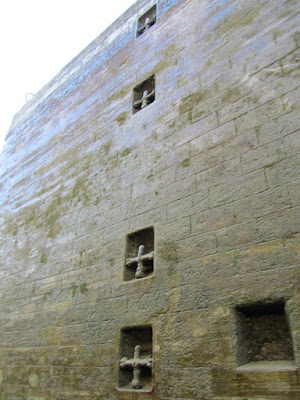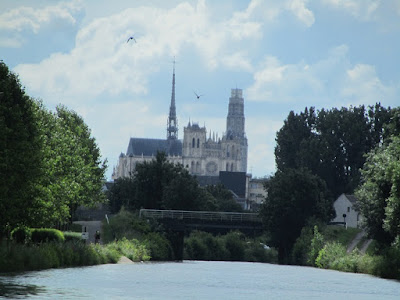These are the adventures of Andy and Sally Rawnsley on their narrowboat "The Puzzler". We have been living on the boat for over nine years now and are still loving it. Our Ulster born Shih Tzu, Shannon, has grown up, and has taken over the boat! After three wonderful years in Ireland, we transported The Puzzler to The Netherlands, and spent a year there. In 2015 we went southwards, to reach the north of France by June. After glorious weather throughout the summer, we arrived in Roanne in late October, and enjoyed our winter in this friendly port. We cruised extensively in France in 2016, 2017 and 2018, returning to Roanne each winter.
Saturday 30 July 2016
23rd - 30th July. On the St Quentin Canal at Cambrai, followed by the Canal de L'Oise à L'Aisne
At Cambrai our canal becomes the St Quentin. The locks are much shorter than on the Canal du Nord, with one barge filling the chamber.
The locks come in pairs, but nowadays only one is in use each time, so watch those lights! We have a remote control to operate the locks. At lock 16 we met a double red light, but a phone call found help, even though it seemed to take a long time to come.
We waited overnight before Riqueval tunnel, but this Dutch hotel barge arrived on Monday morning, having also had lock problems yesterday. He is on one tow line behind the electric tow tug, but we did not realise this until they set off. The men wanted us to be behind him on two 30 metre lines, crossed in front of The Puzzler. After half an hour of trying and failing to get the lines both even and long enough, they told us to follow them using our own engine!
This tunnel is 5670 metres long, which is 3.53 miles, and is the longest canal tunnel in France. It was cut in the time of Napoleon. We expected to have to pay for using this tunnel, but it now seems to be free, which is good.
In some parts of the tunnel there are bricks on the walls, but some of it is completely cut out of solid rock.
Here is the tow tug. The electricity, coming from an overhead line, turns the drum on the boat, which pulls the chain over the boat, all the way through the tunnel. It can pull up to thirty barges at once, but the canal does not now seem busy enough to need the tug at all.
A little further along the canal is Lesdine tunnel, but it is a mere 1098 metres long, with no tug. We are still on the summit level, where the canal is at the bottom of a leafy canyon.
There is a large marina at St Quentin but we chose to carry on out into the country.
On a small island in the middle of the canal is an idyllic mooring. There were several picnic tables, and a barbeque table, ready to use, with a supply of wood. From the far side of the island we could see the start of the Upper Somme Canal, which closed in 2004. The lock had been newly painted, while several men were cutting the grass there. It certainly did not look closed! We were joined on our island by a yacht, on its way back to Norway from the Mediterranean. They will collect their mast in Amsterdam, then continue by sea from there.
Moving on to Chauny, these monkeys were swinging above the flowers. We were pleased to find fuel here, beside the canal, having failed at both Cambrai and St Quentin.
Inside the church, the best part was the wall painting above the altar.
Just to the south of Chauny, we turned left on to the canal de L'Oise à L'Aisne. The first lock is a rise of 4 metres, but is very gentle. If I had known it was a nice lock, I wouldn't have climbed that long ladder, to tie The Puzzler securely to a bollard! Immediately after the lock is an aqueduct over the river Oise, which is the same river we cruised up, on leaving the flooded River Seine in June. We had to squeeze into the side after the lock to let a large barge through, before we could go on to the aqueduct.
We are now at Guny, another pleasant mooring, with a wash day in progress. At last the blog is up to date!
Sunday 24 July 2016
18th - 22nd July. Going North on the Canal du Nord, then the Canal à Grand Gabarit, before turning to the south on the Escaut à Petit Gabarit, joining The Saint Quentin at Cambrai.
From Peronne we continued northwards on the Canal du Nord, with its enormous locks, and guillotine bottom gates.
There is a lot of commercial traffic on this canal, with many of them being double length barges, like this one coming out of the lock.
As we approach Royaulcourt Tunnel the light is green for us. This tunnel is 4354 metres long, but has a wider section in the middle, where boats can pass safely.
We met no boats in the tunnel, but this barge was rather upset as they had had to wait for us, a mere pleasure boat!
Both sides of the canal are angled, but these “safety hooks” come regularly, to save anyone who might fall in.
Having tied up to wait for barge Spica and his pusher to exit one lock, we are hoping that he can see us, and can also steer past us! This is a big canal, but barges always have a large blind spot, in front of them. Having said that, we have always found them to be extremely considerate on this waterway, often even slowing down when boats are moored.
These metal hooks are used in the locks for our ropes, whether going up or down. On this section we are going down, which is a relief, as it is a long way between the two middle hooks. It would be more difficult to move the rope if going up.
It must have been many years since this bridge saw a paintbrush!
Hope is at hand though! This next one is half finished, and looks great.
The Canal du Nord ends at Arleux, to become the Canal à Grand Gabarit. We saw 43 barges tied up around this junction.
The Canal à Grand Gabarit runs from Dunkirk through into Belgium and we were expecting it to be very busy, but we only saw one barge on this twelve kilometre stretch.
Turning off, we took a pretty unnamed short cut which will lead to the Escaut à Petit Gabarit.
Suddenly the narrow waterway opened out into this huge lake, with so much mooring. We saw two sailing dinghies at the far end, but no other boats were moving.
Reaching the Escaut à Petit Gabarit, we found it to be a lovely canal. Don't worry, it is not all straight!
It is not often that a photo can be taken, looking directly at the sun!
We stopped on the main canal at Cambrai, but the marina is just across the grass from our mooring.
Friday 22 July 2016
11th - 17th July. Upstream to Abbeville, where Martin and Jenny joined us, then up the canal de la Somme to the Chateau de Long, Samara, Amiens, Corbie, Chipilly, Cappy and back to Peronne. A busy week!
The station at Abbeville is an impressive building. Martin and Jenny joined us here.
We visited the Chateau de Long, where we had a guided tour of the ground floor. Our guide was the current owner, who has lived there for 15 years, and she was most enthusiastic, having done much of the renovation herself. It was all very impressive.
This deer and fawn was my favourite statue in the extensive gardens.
Inside one greenhouse there was a tropical collection of exotic plants, but it was rather too warm for comfort!
We moved on to Samara, where this Bronze age village is a part of the prehistoric park in the Somme valley. Here archaeology was brought to life, with fire lighting shown, using a flint to strike marcasite to make a spark. Hunting and the many uses of the hides obtained are all demonstrated at this fascinating place, which celebrates 600,000 years of prehistory in the Somme region.
Shannon decided that if she were not allowed to go on outings with us, then she would impress us by being a living statue!
Carrying on into Amiens this view, as we approach on the river, gives the best view of the cathedral.
The Notre Dame Cathedral of Amiens is enormous, being twice the size of Notre-Dame de Paris, and is the largest Gothic edifice ever built. It is interesting that the two main towers are different to each other. We really enjoyed our visit here.
The detail on the front facade is amazing, having been carved originally in 1475.
At that time all the figures were in colour, and this fantastic evening light show brought it back to the way it was then, with high-definition digital images. Sorry about the dark, but it is after 11pm!
For part of the show, a cloud effect covered the top part of the facade, making us all feel giddy!
Never mind posing for a photo, Shannon is watching the show!
As a real contrast, this skyscraper was built after 1945 and is said to be the first one built in France.
Andy and I saw this concert in front of the Town Hall, while Martin and Jenny enjoyed visiting the Jules Verne house. This is a lovely city.
Next morning we went up Amiens lock, with Martin crewing for the deepest lock on the Somme. Well, he is a sailor after all!
We were allowed to see inside the command centre for the whole of the River Somme, which was fascinating. Every boat on the system has its own named marker, which is moved as the boat moves.
Stopping on the top town mooring, we eventually found the base for the punt-like boats known as barque à cornet, for a trip round The Hortillonnages. Do not make the error which we nearly did, and think that it is the small trip boat operating on the main canal, which is just a water bus.
The punt takes us on a magical tour through the small canals of this large area of market gardens, as well as decorative gardens, all aiming to win the July competition for the best waterfront.
Our last visit in Amiens was across the river to see the medieval waterside district of St Leu.
Moving on to Corbie, Jenny had a burst of energy and leapt up the climbing frame in the park!
In Corbie, once again there is a splendid town hall, with the flags by the war memorial. We enjoyed a good meal at the restaurant, La Table d'Agathe.
On Saturday morning we visited this statue at Chipilly. It represents an English soldier supporting his wounded horse, and is a very moving memorial.
The weather continues to improve and Jenny too proves her nautical skills, showing great concentration.
At Cappy we played boules again, with Martin throwing the winning boule.
Back to Peronne, where the mooring was busier than when we were here last.
On the way into town this flower bed represents the memorial flowers of both England and France, poppies and cornflowers. No doubt this is to commemorate the centenary of The Battle of the Somme.
The Historial de la Grande Guerre is to be found in Peronne castle, and made an interesting finish to a memorable week. Jenny and Martin leave us tomorrow.
Subscribe to:
Posts (Atom)























































